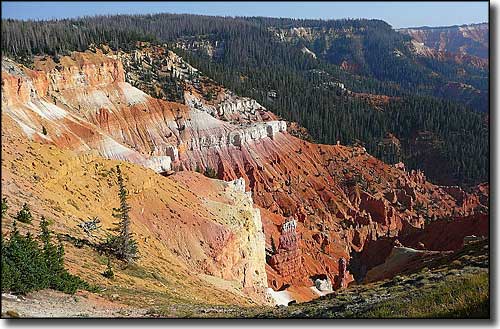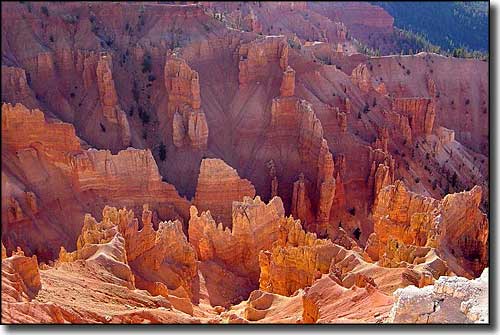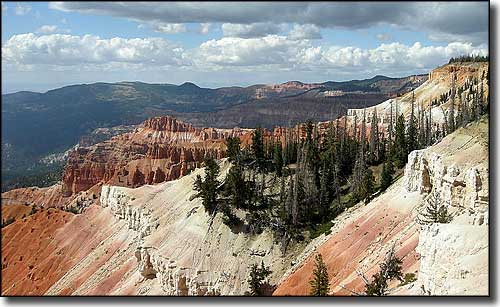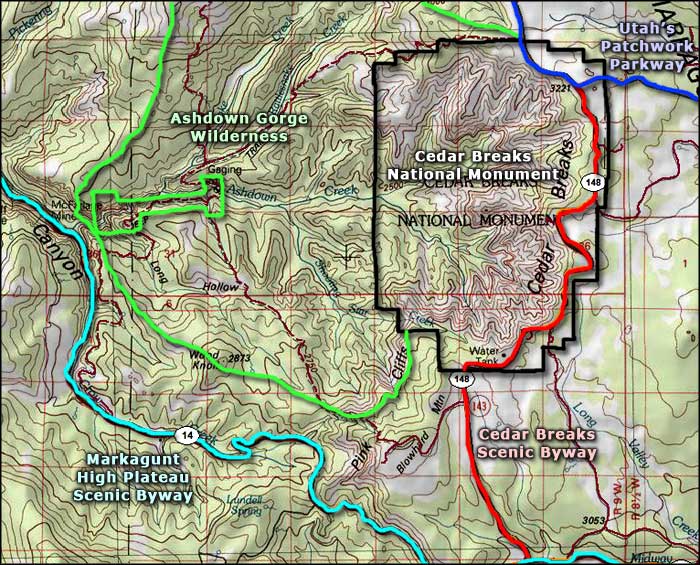
Cedar Breaks National Monument

Cedar Breaks National Monument
Cedar Breaks Natonal Monument encloses a spectacular natural amphitheater more than 3 miles wide and 2,000' high on the western edge of the Markagunt Plateau. The Markagunt Plateau is on the western edge of the greater Colorado Plateau, and is made up of the same materials as Zion National Park: shale, limestone and sandstone that were deposited at the bottom of ancient Lake Claron about 60 million years ago. Those materials were compressed over time by overlying layers of depositional and volcanic materials, then they were uplifted by geologic processes and exposed by erosion. Erosion continues today at the rate of about 2" every 5 years. The top of the plateau is still in place as it is composed of a hard rhyolitic tuff that was laid down in large volcanic eruptions some 28 million years ago. The rock is red and purple because the living creatures in that ancient lake concentrated iron and manganese in their bodies and then deposited that in the sediments of the lake when they died and fell to the bottom.
Cedar Breaks National Monument was established in 1933. Back in those days, a visitor's lodge was built near the south end of the canyon, but that was razed in 1972. There is a newer visitor center located on the canyon rim but at an elevation around 10,350', it is only open from June through October. The upper elevations of the property are usually snowed in from October through May. There is also a campsite near the canyon rim and several hiking trails in the monument. In 2006, a legislative proposal to expand the monument to include the Ashdown Gorge Wilderness (at the foot of the natural amphitheater), the nearby Flanigan Arch and some private land, and then rename the whole Cedar Breaks National Park was under consideration. To date, there doesn't seem to be anything happening with it.
Access to Cedar Breaks National Monument is usually via the Cedar Breaks Scenic Byway (Utah Highway 143) which runs between U-14 (the Markagunt High Plateau Scenic Byway) to the south and U-148 (Utah's Patchwork Parkway) to the north.
The Cedar Breaks National Monument Visitor Center is open from 9 am to 6 pm daily between early June and mid-October only. Snow can begin to pile up anywhere from late October to early December, and that's when the road gets closed. Snow often remains through late May/early June. When the snow is gone is when the road opens up again. In that time period between when there's enough snow on the ground to support snowmobiling and cross-country skiing, that is allowed to happen.
When the Visitor Center is open is when it costs $4 per person to visit Cedar Breaks (and the fee is good for seven days from date of purchase). When the Visitor Center is closed, access to the National Monument is free. The campground at Point Supreme is only open when the Visitor Center is open. It offers 28 campsites (none with hookups) for $14 per site per night. All sites are available first-come, first-served. There are restrooms and showers available in the center of the campground. The stay limit is seven nights.

Hoodoos at Cedar Breaks National Monument

Looking across the rim of the amphitheater

Cedar Breaks - Ashdown Gorge area map
